From: Dornoch to Golspie
Distance: 14m / 22.5km
Cumulated distance: 1128m / 1815km
Percentage completed: 95.3
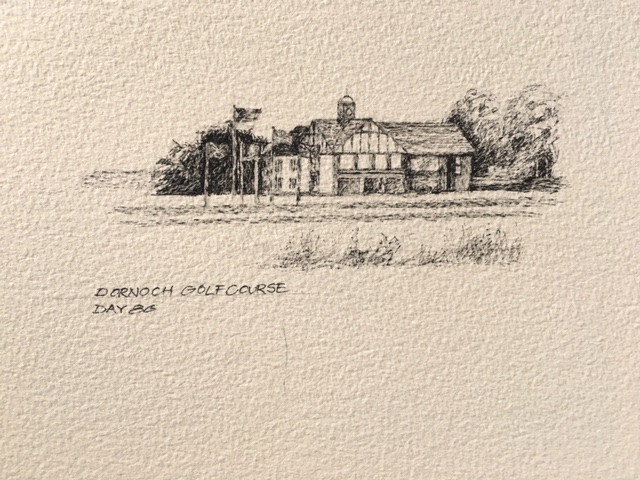
‘When the Earl and Countess were poisoned at Helmsdale Castle one night in 1567, the walls of Dornoch Castle trembled. When the Earl of Caithness, the chief suspect, took possession of the surviving boy-heir, the Earl Alexander, the walls of Dornoch shook. When the Murrays of Dornoch, allied with the Gordons, snatched the young Earl Alexander from Dunrobin Castle where he was being held, the northern heather was set abaze. The Clans marched and for Dornoch Castle there began four centuries of ruin and restoration.’
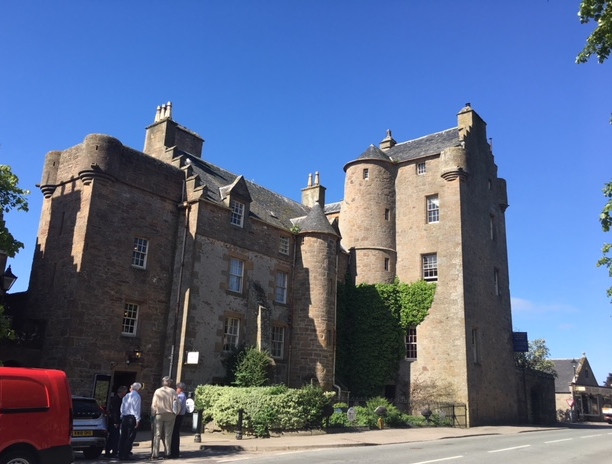
Dornoch Castle .. well worth a visit
Last night Gus and I slept in Dornoch Castle, soaking up the sense of history (and Americans celebrating their first night in Bonny Scotland). If I was a film-maker I would be planning the next block-buster based on the stories emanating from its walls. I’ll share just one with you about St Gilbert (the chap in the field from yesterday), who founded Dornoch cathedral. laying a curse invoking the wrath and indignation of the Almighty, on anyone who might ‘distract and injure’ the building. Well, the Caithness forces did just that in 1570 when William Sutherland of Evelix kicked open St Gilbert’s tomb. The result was fearful. Here is the account, in the original words of Sir Robert Gordon, a historian writing just 10 years after the event:
“He opened Gilbert his grave, burst St Gilbert his coffin with his foot, and threw the ashes of that holy man with the kind which enormitie the Almight God did most justlie punish; for that same foot that burst St Gilbert his coffin, did afterwards rot away and consume, to the great terror of all beholders, whereby, this William Sutherland grew so lothsum that no man was able to come neir with him, and so he died miserablie.”
See what I mean? You’re missing a trick, Quentin.
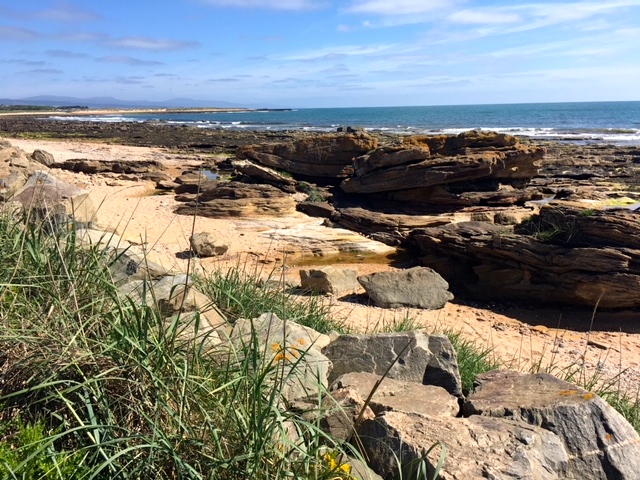
Rock pools

Looking back
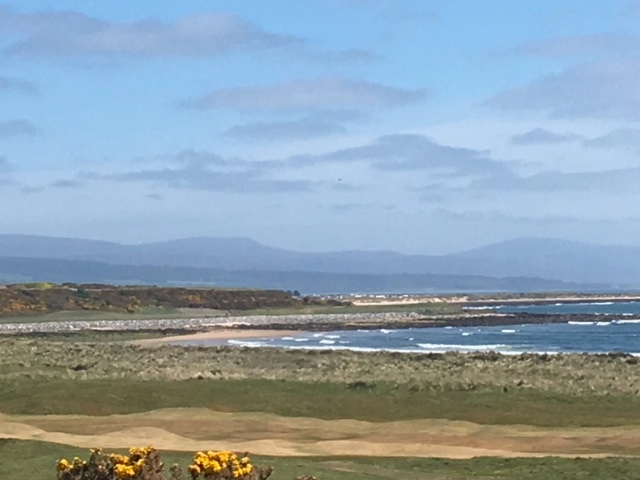
Coast north of Dornoch
First up on our route yesterday was the world famous Dornoch Golf Course, where The British Open has been played on several occasions. It’s a spectacular links course, with narrow fairways and tightly-guarded greens. Gus had played it several years before and with the amazing memory that he has for terrain, was able to remember how he and his dad had played on many of the holes.

Flags at the first
There’s a tradition of raising the national flag of each player at the start of their round. You can just about make out the Swiss and Scottish flags in the photo.
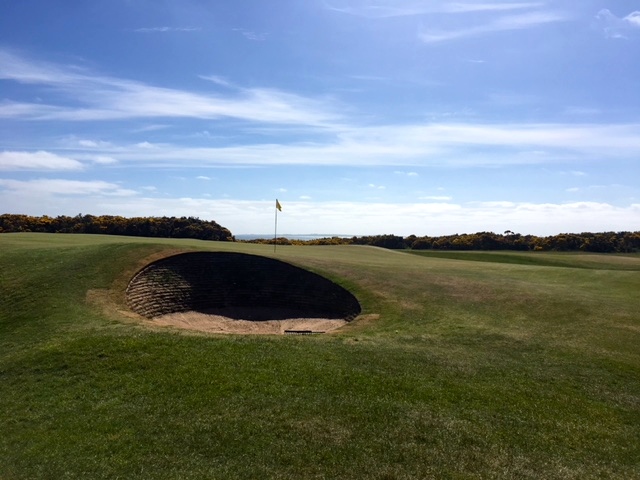
Punishing bunkers
The coast line was spectacular and we were blessed with continuing bright and sunny weather, even though the wind might have been somewhat bothersome for the golfers.
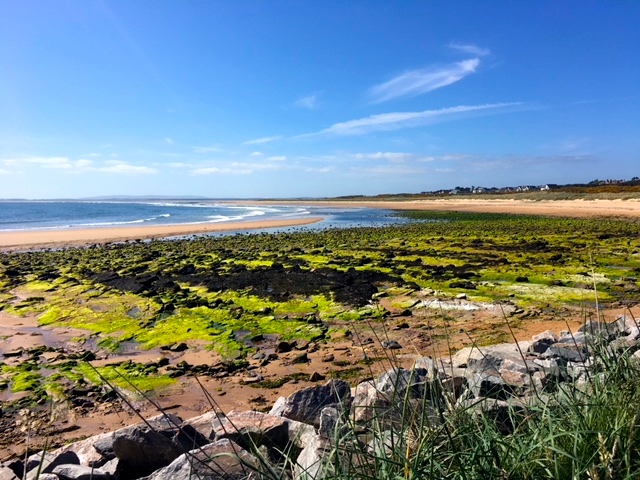
Vivid colours of the coast

Extremely pleasurable walking
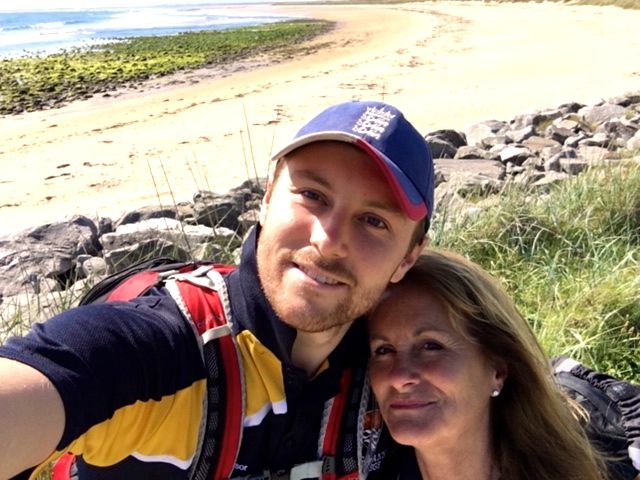
Ahhh!

And one for my Dad .. the blue gentians he loved but could not grow
We were able to avoid the A9 once more by following the John o’Groats Trail. At times the tall bracken and gorse meant locating it was difficult but there’s no doubt that it was much, much prettier than the using the busy road.
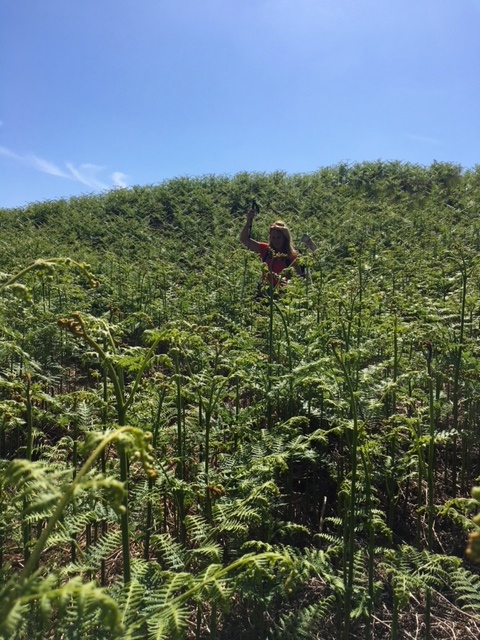
Cutting a swathe through the bracken

Gus grasping the nettle, so to speak
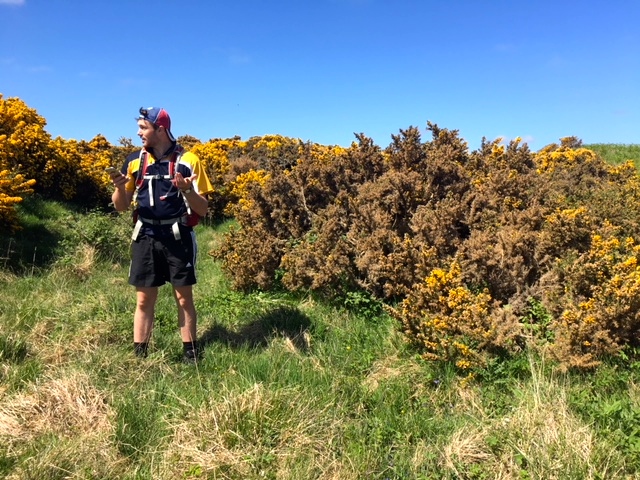
And where to now?
It was a couple of months and many miles ago that I was tempted by a ferry in Cornwall, to make my route shorter. Yesterday I would have been chopping off a great chunk of the route by crossing Loch Fleet by ferry. But we held strong and did not give into temptation. Instead we mused long and hard about carrying our packs on our heads and wading through the water, which didn’t look so very deep. But then we saw the seals and thought again. There must have been upwards of a hundred Common Seals basking on the sandbars, in the afternoon sun. June is the month for seal pups to be born and we figured it wouldn’t be a good idea to antagonise the new mums.

Loch Fleet and the seals
Turning westwards along the estuary, we could see the remains of Skelbo Castle. It faces Littleferry across the water. The Sutherlands of Skelbo were part of the Caithness and Mackay Clans force which had held Dornoch siege back in the sixteenth century. Judging from the ruinous state of the castle, it didn’t fare so well in the future.

Skelbo Castle
It was a long walk to Mound Bridge, which gives the A9 its way of crossing the very wide estuary. Along the way there was plenty to see .. escaped sheep, oyster-catchers, herons and buzzards flying overhead. From all around we could clearly see Ben Bhraggie and the 30m tall statue of the Duke of Sutherland, which stands on the summit. It’s an extraordinary sight being so prominent. And like several statues of 18th and 19th century statesmen around the world, its life may well be threatened. Granville Leveson-Gower was a millionaire MP in the late 18th century. He became duke when he married Elizabeth, Countess of Sutherland. Their land at that time made up the largest private estate in Europe.

Escaped sheep

Wide estuary
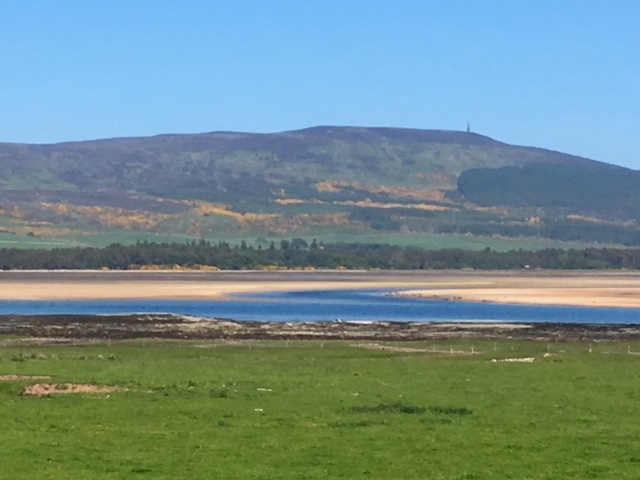
Duke of Sutherland atop Ben Bragghie
Apparently the duke was horrified by the living conditions of the rural people of inland Sutherland and strongly believed that the land very soon would not sustain them. And this is where it starts to get a bit murky .. his solution to the problem was to resettle thousands of families along the coast, to replace them with many more thousands of sheep, which of course cost nothing to manage. He was the most prominent figure in The Highland Clearances and his dramatic, forced removal of the people .. despite his possible good intentions .. is still keenly felt. And attitudes to keeping or removing his statue have been mixed. I think I come down on the side of the locals who say, ‘It is part of history. If you take away history nobody will ask questions. If he stays there people will ask what it is and then hear what happened during the Highland Clearances’.
The John o’Groats Trail cut off a good kilometre of A9 walking on the approach to Mound Bridge. It meant rolling up the socks again to avoid getting stung by nettles but we were grateful to the volunteers who have created this alternative to the treacherous road, which has little to no verge.
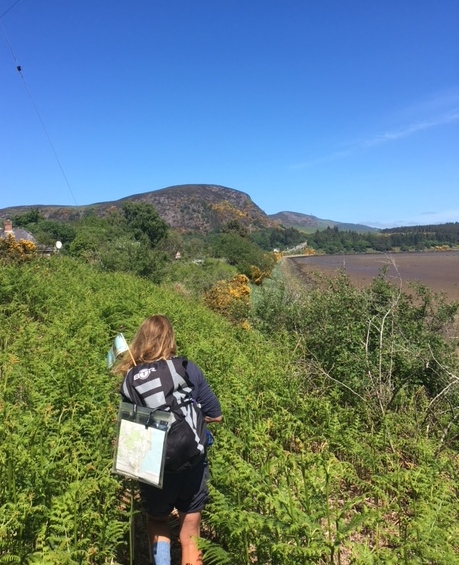
The Trail approaching the bridge

View from Mound Bridge
After a couple of kilometres on the road we were able to turn off right across the fields, to the teeny village of Kirkton, where we knew we could retreat to Balblair Wood. It would take us neatly back to the coast. Passing by one of the crofts, next to the railway line, a villager came out to chat. A few years back he’d had the Naked Rambler pass by on his way, when walking the length of Britain. He’d invited the Rambler and his girlfriend in for supper and a bed for the night. The Naked Rambler, aka Stephen Peter Gough, is a British activist and former Royal Marine and prisoner of conscience. In 2003–04, he walked the length of Great Britain naked except for his boots, but was arrested when he did it again in 2005-06. The villager was keen to tell us that the Rambler and his partner donned boiler suits when accepting his hospitality. The whole tail reminded me of Jimmy, the Queenslander I’d met on the West Highland Way, who was not naked but wore no shoes .. far braver in my book.

Cutting across the fields
The woods were quiet and such a respite after the blaring traffic of the road. Balblair is known for its rare wild flowers and plants as well as its birds, deer and pine martens. I didn’t hold out much hope of seeing the sweet little pine martens as they’re nocturnal, but I do know that they have chestnut-brown fur with a creamy-yellow bib and that their tails are long and fluffy. This would have been a good night for wild camping, perhaps. Or perhaps not.

Balblair Wood
Golspie was our stop for the night. It’s a lovely sea-side village and we walked the length of Golspie Golf Course to reach our accommodation on the outskirts. Being able to bath and lie on the bed, quickly convinced me that wild camping was not for me.
Black Dog Tails
Brenda Owen was walking her labrador retriever Penny in Wales when she spotted a wheelchair on the shore and a body in the water. Quick-wittedly she shouted, “Fetch!” and Penny did just that. She jumped into the water and dragged the woman back to the riverbank, from where she was taken to hospital. Get the link to the story when you click on the pic.
![]()



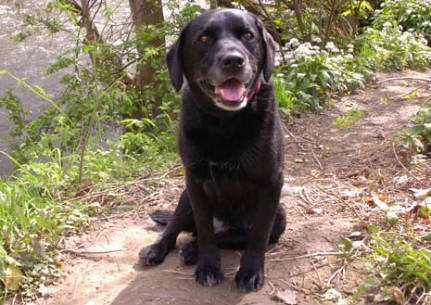
Not far now. It will be an emotional time . You have had pretty good weather (post the beast i e ). Thinking of you as you swiftly approach THE DAY. xx
Thank you, Marilyn. Loving this part of Scotland .. the coast is glorious. x
Dear Jules – absolutely sublime photos – so fascinating to see a totally unknown (to me) and breathtaking part of Scotland/Great Britain. Grey and rainy down here in Dorset! Fabulous photos of you and Gus. What a joy he is!! Only a handful of days left …sob…Lots of love xx
Cannot believe the luck I’ve had .. no rain since hitting Scotland! And surprises from Gus and Patrick! Enjoy Dorset .. so lovely even when it’s grey. xx
Not many days to go now. I can only admire your persistence, fortitude and humour throughout.
These last days from Inverness are particularly interesting to me as they will probably form the next stretch of my LEJO, taken over 50 years, when I return from foreign lands. I am thus following your every step.
I’m sure there will be a black labrador wagging his/her tail for you at John o’Groats.
Just 4 to go, John. So far we’ve been able to shun the A9 but I’m not sure about the last few days. Will it be your last stretch? I do so hope there’s a black lab at the end .. would totally be the icing on the cake!
Hello !jules.
Congratulations for your “Walking the black dog”
It s absolutely Fantastic and you are Wonderful.
Take care.
Kind regards
Sylvianne ( Sophie s friend)
Thank you so much, Sylvianne .. I’ve heard so much about you! I hope you had fun in Paris with our friend, Sophie. My best, J
Just three more days, and you’re there. Just looked at images of John O’Groats on line – if one blinks, one might not see it….but maybe it’s sizable compared to some of your stops along the way?
Hope the foot is bearing up, I’m sure distillery stops help, one way or the other???
Amazing achievement!
It’s a little like Land’s End actually .. just can’t believe it’s only 4 days away! xx
Do you feel like slowing down? Take in all -and more- in the next few days? Hope your foot and the weather are holding up! You have a good medic along. Love that tape!
xxx Amely
He’s had plenty of practice with his own feet! Amazing weather still. xx